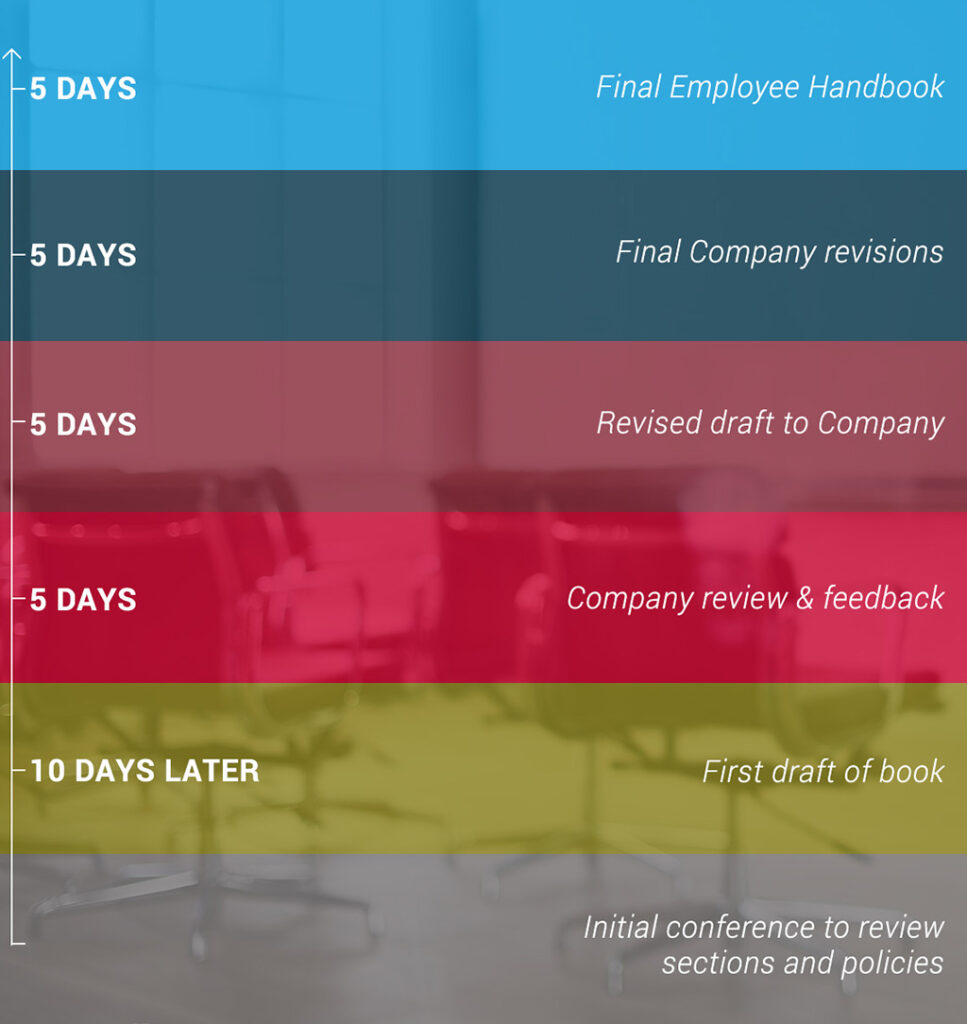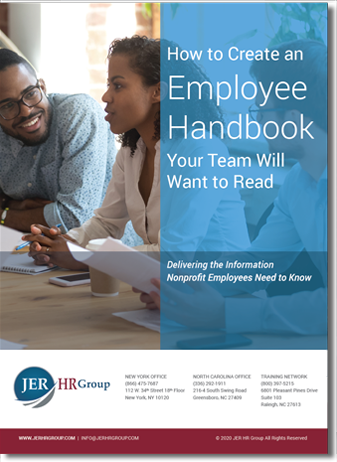hr policies & employee handbooks
Delivering the information employees need to know
Creating employee handbooks that are integral to the employee relationship.

hr policies employee handbooks
Delivering the information employees need to know
Creating employee handbooks that are integral to the employee relationship.


Employee Handbooks
Delivering the information your employees need to know
JER HR Group helps your create an Employee Handbook that is integral to your employee relations philosophy, essential to your employee communications, and crucial to your development of an effective, safe, and legal work environment.
An Employee Handbook of policies, procedures and benefits exists to ensure compliance with your organization’s legal requirements and to create a transparent, fair workplace. If you don’t have one, you need one. And once you have one, it needs to be reviewed and updated once per year.
What should your Employee Handbook do?
- Acquaint all employees with the company’s culture, mission, and values.
- Share with employees what is expected of them.
- Let employees know what they can expect from management and leadership.
- Showcase the benefits that your organization provides.
- Communicate key company policies clearly and consistently,
- Maintain compliance with current federal and state laws.
- Help protect the company against employee claims.
- Inform employees as to where they can go for help.

What should your Employee Handbook do?
- Acquaint all employees with the company’s culture, mission, and values.
- Share with employees what is expected of them.
- Let employees know what they can expect from management and leadership.
- Showcase the benefits that your organization provides.
- Communicate key company policies clearly and consistently,
- Maintain compliance with current federal and state laws.
- Help protect the company against employee claims.
- Inform employees as to where they can go for help.


It’s more than the basic employment information.
When done right, the Employee Handbook is part of your brand story, and has the power to reinforce the employee’s decision to work with your company. It is integral to your employee relations philosophy, essential to your employee communications, and crucial to your development of an effective culture and work environment.
An Employee Handbook can be an effective tool for communicating with new hires or the existing workforce. In most cases, the handbook is the first opportunity to provide written information to employees regarding the culture and work environment in which they will be spending much of their time. It is also the quickest, easiest, and most organized way for employers to consistently deliver critical information.
The handbook will be the resource for employees to do their research and obtain answers. Since many (if not the majority) of personal issues experienced by employees are unique, it may give them the chance to clarity their questions and issues before approaching their supervisor, manager, or Human Resources department.
Every organization should give the Employee Handbook the time it deserves. A good handbook demonstrates the respect and care that the employer has for its employees, and it communicates policies and procedures in a way that contributes to effective performance with less stress. Employees are important stakeholders within the company and deserve to be treated as such. A good Employee Handbook can do just that.

It’s more than the basic employment information.
When done right, the Employee Handbook is part of your brand story, and has the power to reinforce the employee’s decision to work with your company. It is integral to your employee relations philosophy, essential to your employee communications, and crucial to your development of an effective culture and work environment.
An Employee Handbook can be an effective tool for communicating with new hires or the existing workforce. In most cases, the handbook is the first opportunity to provide written information to employees regarding the culture and work environment in which they will be spending much of their time. It is also the quickest, easiest, and most organized way for employers to consistently deliver critical information.
The handbook will be the resource for employees to do their research and obtain answers. Since many (if not the majority) of personal issues experienced by employees are unique, it may give them the chance to clarity their questions and issues before approaching their supervisor, manager, or Human Resources department.
Every organization should give the Employee Handbook the time it deserves. A good handbook demonstrates the respect and care that the employer has for its employees, and it communicates policies and procedures in a way that contributes to effective performance with less stress. Employees are important stakeholders within the company and deserve to be treated as such. A good Employee Handbook can do just that.
Download our free white paper
How to Create an Employee Handbook Your Team Will Want to Read
Delivering the Information Nonprofit Employees Need to Know
The Employee Handbook provides the basic employment information that every employee needs to know. When done right, the handbook is also part of your brand story, and has the power to reinforce the employee’s decision to work with your company. The basic question is how to get there.

Resources
JER HR Group and NexaLearning jointly announce their plans for NexaLearning to join JER HR Group effective immediately. …
JER HR Group and Human Resources Plus jointly announced JER HR Group’s acquisition of Human Resources Plus, Inc. today. Human Resources Plus (HRP) is a HR consulting firm and online HR document provider …
JER HR Group LLC acquires Willis HR LLC, a HR Consulting firm. JER HR Group and Willis HR jointly announce JER HR Group’s acquisition of Willis HR in a private transaction. Willis HR is a leading HR consulting …
LET’S TALK ABOUT PEOPLE, IDEAS, AND SOLUTIONS.
NEW YORK OFFICE
112 W. 34th Street 18th Floor
New York, NY 10120
NORTH CAROLINA OFFICE
6801 Pleasant Pines Drive, Suite 103
Raleigh, NC 27613
ARKANSAS OFFICE
900 SE 5th Steet Suite 22
Bentonville, AR 72712
TEXAS OFFICE
8708 Technology Forest Place
Suite 175 PMB 1024
The Woodlands, TX 77381







